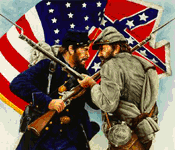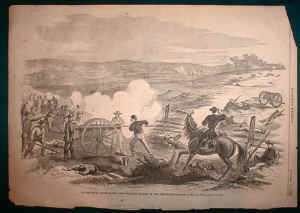 |
Civil War Battles |
|
State War Records |
| AL - AK - AZ - AR - CA - CO - CT - DE - FL - GA - HI - ID - IL - IN - IA - KS - KY - LA - MA - MD - ME - MI - MN - MS - MO - MT - NE - NV - NH - NJ - NM - NY - NC - ND - OH - OK - OR - PA - RI - SC - SD - TN - TX - UT - VT - VA - WA - WV - WI - WY |
The Battle of Swift Creek
May 9, 1864 in Chesterfield County, Virginia
 |
|||||||||||||||||||||
|
Earlier in the day, the Federals had left Bermuda Hundred and marched west and south in a renewed effort to wreck the railroad between Chester Station and Petersburg. Maj. Gen. Benjamin Butler, now intent on avenging reverses suffered by the Union army at Port Walthall Junction on May 6 and 7, established the particular objective of destroying the rail and road bridges which crossed Swift Creek. On the morning of the 9th, Brig. Gen. Smith's advance carried his command through Port Walthall Junction, where unburied Union corpses lay bloated in the 102 degree heat.
The Union force arrived near Arrowfield Church by early afternoon, and deployed for action with the brigades of Burnham, Marston, and Heckman straddling the railroad and turnpike. The brigades of Wistar, Alford, and White supported the Union line from the turnpike west to Brander's bridge, and on the far left flank, Martindale's Brigade was posted 2,350 yards north of Forth Clifton.
The battle began on the 9th, with heavy skirmishing between Heckman's "Star Brigade" and the 11th South Carolina. Confederate artillery fire soon disrupted the Union advance, forcing the 13th New Hampshire to seek cover behind the railroad embankment which bordered the Thomas Shippen farm. Butler made a thrust toward Petersburg and was met by Bushrod Johnson's Division at Swift Creek.
During the mid-afternoon a series of contradictory orders reached Gen. Joseph Johnson from Gen. Pickett in Petersburg. These orders resulted in an ill-advised "reconnaissance in force" made across the creek. Gen. Hagood, angered by the danger in which his 2 regiments had suddenly been placed, later recalled that it was "perfectly evident that the enemy was there in force" and that he obeyed the order to advance in the reluctant knowledge that his few troops "could accomplish nothing."
Seeing that the 11th was becoming heavily engaged near Arrowfield Church, Hagood ordered the 21st quickly forward in support. Unfortunately, Col. F. H. Gantt (of the 11th) mistook this movement as a general Confederate advance, and ordered his regiment to charge Heckman's Brigade on his immediate front. The South Carolinians moved forward on the run, fortified by the famous "Rebel Yell." Gantt's impromptu charge was however, soon repulsed resulting in heavy Confederate losses. The Union forces did not follow up. The remainder of the fighting at Swift Creek consisted of general skirmishing and limited sorties by both sides. One spirited artillery dual did occur between a Union battery posted near the Shippen house and a Confederate battery.
As skirmishing continued along Swift Creek, 5 Union gunboats steamed up the Appomattox and began to shell Fort Clifton. Their efforts proved fruitless, however, because the high elevation of the fort gave Confederate gunners a decided advantage. After the army gunboat Brewster had been sunk and the Chamberlain barely escaped after being run aground, the small Union flotilla retreated down river to City Point. Although the threat of the gunboats had been defeated, Fort Clifton remained under fire throughout the afternoon. The night of the 9 - 10th was disturbed by incessant skirmishing and the Union force stood "practically in line of battle all night."
At 7:00 A.M., a Union battery opened fire briefly on the Confederate lines, but Confederate salvos fired 2 hours later (and again at noon) failed to draw return fire. Consequently, at 1:30 P.M., Johnson sent skirmishers across the creek to investigate. To their surprise, the entire Union army had withdrawn. No real attempt was made to pursue the retreating Federals, who suffered only 2 casualties during the withdrawal to Bermuda Hundred, where they arrived at 5:30 P.M. that evening. After skirmishing, Butler seemed content to tear up the railroad tracks and did not press the defenders.
In conjunction with the advance to Swift Creek, 5 Union gunboats steamed up the Appomattox River to bombard Fort Clifton, while Hincks's U.S. Colored Troops infantry division struggled through marshy ground from the land side. The gunboats were quickly driven off, and the infantry attack was abandoned.
The fighting at Swift Creek was over. The bridges over the creek had been saved and, although Hagood's Brigade had been badly battered, the temporary safety of Petersburg had been ensured. Hagood's men, along with those of Bushrod Johnson and the defenders of Fort Clifton, were recognized as the "saviors" of Petersburg and praised for their efforts of May 9. After Swift Creek the fighting soon shifted north, and during the entire siege of Petersburg the Swift Creek line remained quiet.
